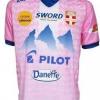Search the Community
Showing results for tags 'torino'.
-
I recently purchased this pen from a person in Italy; she said it was a custom made celluloid pen (no brand) from the 2000's, but I was wondering if someone can recognize the nib manufacturer. The pen was made in Turin (Settimo Torinese, to be precise). Thanks for your help.
-

The Filcao Roxi: Underdogs, Natalia Ginzburg, And Settimo Torinese
bobje posted a topic in Fountain Pen Reviews
Americans love underdogs. We revel in stories about how the British had their hind-ends handed to them in the American Revolutionary War, 240 years ago, and it was us – poorly clothed mongrels – who did the handing. This idea of underestimated integrity comes to me when I consider two unlikely subjects: the Italian city of Torino, and a fountain pen that originated there, called the FILCAO Roxi. When non-Italians think of Italy, four cities come first: Rome, Venice, Florence, and Milan. For a century or so, Torino came in fifth or sixth, somewhere in a tier with Naples and Bologna. Then, two things happened. First, FIAT turned Torino into the Detroit of Italy. And second, in 2006, Torino hosted the Olympic Winter Games. Suddenly, Torino had name recognition. No longer just an industrial city west of Milan, it was transformed into something much more magnetic than a Detroit. Torino was now the Italian gateway to the Alps -- the Denver, Colorado, of Italy. Naples is the undisputed home of the comic Italian underdog, but Torino is overlooked as well. You probably didn’t realize this, but the Swiss used to visit Torino in the 1700s to learn how to make chocolate and to buy chocolate-making machines. Torino is chocolate paradise, and there is a famous and elegant café called Baratti e Milano, in the center of the city, where people buy bite-sized chocolate ingots called “gianduiotti.” Like Nutella, gianduiotti are a mixture of chocolate and hazelnuts, and they are rich, smooth, and magnificent. But beyond the famous cafes, there are lesser-known, family-run, off-the-beaten-path places to buy chocolate – Peyrano, for example, or Pfatisch. The Aurora company, founded in Torino in 1919, is the oldest of Italy’s many fountain pen companies. Run by the Verona family, Aurora may be the most autonomous and financially healthy of these. But for decades, seven Roman miles east of Torino on the road to Milan, there was a cluster of small, family-run companies making pens, writing instruments, and components. In 1963 a guy named Franco Grisolia founded one of these, FILCAO, in a place called Settimo Torinese. Unfortunately, after five decades in the pen business, Grisolia died early in 2015. His was one of the last remaining pen companies in Settimo. FILCAO, like FIAT, or OMAS of Bologna, is an acronym. It stands for Fabbrica Italiana Lavorazione Cappucci Alluminio Ottone (Italian Factory for Aluminum and Brass Cap Processing). Under Franco Grisolia, FILCAO first made components, and then charted an oblique orbit in the already eccentric solar system of Italian fountain pens. That niche was pens designed for writers, in classic designs from the 1930s and 1940s, at prices that were unusually reasonable by Italian standards. Just looking at FILCAO pens evokes underdog western brands with integrity – they’re more like Esterbrook and Wyvern, than Parker and Onoto. Like Torinesi discussing a favorite ciaccolateria, we live for the chance to argue distinctions among obscure brands. Enough history. This is a review of the FILCAO Roxi, and what I can summarize briefly is that it’s a lightweight but largish resin pen that writes smoothly. The cigar-shaped design is based on the ogiva, or ogee, or pointed arch, found in architecture. When this torpedo shape is applied to pens, the fountain pen universe thinks first of Montblanc or OMAS or Sheaffer. But the designers for these companies all based this shape on something, and that something was the pointed arch. The German pen companies, the Swiss, the French, the Americans, the Japanese, the Chinese – they’re not ripping off each other. They’re ripping off Italian architects of Gothic cathedrals, who ripped off architects from ancient Persia, Greece, and China. My Roxi is the color of whipped honey, and it was also available in a Ferrari-like flame red. This resin comes from an Italian company called Sintetica, which also supplies material for Italian eyeglass companies. The Roxi is a piston filler, with a gold Fine nib marked “Iridium Point 585,” in the European style for 14-karat gold (58.5 percent gold, rather than 14/24 parts gold, 10/24 parts other). The nib is resilient – it couldn’t be called flex -- but it displays more give than the steel nibs I usually write with. In the first few hours I used it, my Roxi skipped infrequently, particularly on strokes that went from left to right. But the skipping has mostly stopped, and may have occurred simply because the feed hadn’t marinated in ink long enough. The Fine nib is one of the juiciest and widest I’ve encountered, and the wet, lubricious Aurora black ink of Torino may have something to do with this. A pen review presents a rare opportunity to use the word “lubricious,” and I’m taking it. I like several things about the Roxi. First, it writes well. Second, the design is simple, classic, and symmetrical. It’s almost modest, an unusual trait for an Italian pen. Black ogee finials and a black section bookend the honey-colored cap and barrel, and a two-toned nib balances rhodium trim. Third, Franco Grisolia named the pen “Roxi” after his son, Rosario. People who write with this pen have a connection not just with a company, but with one of the last pen-making families of Settimo. And last, the Roxi was created and launched in 2007, shortly after the Olympic Winter Games, at a high point for Torino’s visibility and confidence. What do I dislike about the pen? Well, there’s the infrequent skipping issue, but that will be easily sorted. There’s a little bit of play in the black ogee cap that turns the piston filler. But what I really miss is an imprint on the barrel. One of the most celebrated FILCAO pens, an even more understated lapis blue model designed by the American pen expert Richard Binder and named, immodestly, “Columbia, the Gem of the Ocean,” proudly displays “Filcao” in an oval on the barrel. I love that imprint. The Roxi sparks one last story from Torino. There is an Italian author named Natalia Levi Ginzburg who grew up in Torino, and whose father was a professor at the city’s university. She wrote a beautiful book called Lessico Famigliare, or Family Lexicon, which was published in 1963 and is still taught in Italian schools. Foreign students of Italian also read Lessico Famigliare because Natalia Ginzburg’s language is simple, modest, familiar, and understandable. Her family lived on the Piazzetta Donatello, across the street from a municipal bathhouse and the Church of Mary Sacred Heart. In 2006, when I searched for her childhood home, the Italians I encountered on this piazza were amazed to learn that Natalia Ginzburg had once lived there and embarrassed to learn this trivia from an American. Fortunately, in 2011, a tree was planted there in her honor. In this neighborhood I like to think of the schoolgirl Natalia of the 1920s, and of a small shop a few blocks away where her parents might have taken her and her brothers and sister to buy chocolate on special occasions. Like FILCAO and Peyrano and many other family-run Italian companies, the future of that store, Pfatisch, is complicated, just as families are complicated. I don’t know what pens Natalia Ginzburg used to write Lessico Famigliare. But in my imagination she uses modest pens for writers, made by families in Settimo Torinese. It’s possible to acquire a FILCAO Roxi, in New Old Stock, from Giovanni Abrate, an Italian American who acquired remaining inventory and rights to the FILCAO brand from the family of Franco Grisolia. I have no affiliation with Giovanni -- Tryphon on FPN -- other than buying the Roxi and the Columbia, and spending time in Torino in 2005 and 2006. More evidence of Torinese integrity: it’s one of the most ecumenical of Italian cities. The city’s most prominent landmark, the Mole Antonelliana, was originally a Jewish temple, and the Italian Protestant church – the Waldensians – was founded and headquartered in Torre Pellice, west of Torino.- 22 replies
-
- filcao
- natalia ginzburg
-
(and 7 more)
Tagged with:

